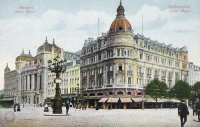Belle Époque
From The Art and Popular Culture Encyclopedia
|
"The archetypal example of succès de scandale in art is Stravinsky's ballet Le Sacre du printemps (The Rite of Spring) , which premiered in 1913 by the Ballets Russes. In the high days of the Belle Époque, the public attending this premiere was so scandalised by the brutal sounds produced by the orchestra and the evocation of a blood sacrifice on stage that a riot broke out. "--Sholem Stein |
|
Related e |
|
Featured: |
The Belle Époque (French for "the pretty era" ) was a period in European history that began during the late 19th century and lasted until World War I.
The Belle Époque was considered a "golden age" as peace prevailed between the major powers of Europe, new technologies improved people's lives, and the commercial arts adopted modern forms. New inventions made life easier at all social levels, the cultural scene thrived, cabaret, can-can, and the cinema were born, and art took new forms with Impressionism and Art Nouveau. Art and architecture in the style of this era in other nations is also sometimes called "Belle Époque" style.
While art and innovation flourished, this time period also saw the rise of working-class militancy and organized socialist movements. These conflicts as well as various political scandals began to polarize the country between the "Left" and the "Right." Regardless, this time period is remembered in France as a golden time of the past that was shattered by the outbreak of World War I.
Contents |
Art and literature
The arts underwent a radical transformation during the decades before World War I, and new artistic forms associated with cultural modernity emerged.
Impressionism, which had been considered the artistic avant-garde in the 1860s, gained widespread acceptance. In the early 20th century Expressionism became new avant-garde. The visual art style known as Art Nouveau (called Jugendstil in central Europe), characterized by its curvilinear forms, become prominent and dominated design throughout much of Europe. Highly successful branches of this style, with notable regional variations, took root in France, Germany, Belgium, Spain, Austria (the Vienna Secession), Hungary, Bohemia, and Latvia. It soon spread around the world, including Mexico and the United States. It is sometimes called Belle Époque style.
Theater adopted new modern forms, including Expressionism, and many playwrights wrote plays that shocked contemporary audiences either with their frank depictions of everyday life and sexuality or with unusual artistic elements. Cabaret theater also become popular. Musically, the Belle Époque was characterized by salon music. This was not considered "serious" music but, rather, short pieces considered accessible to the audience. In addition to pieces for piano solo or violin and piano, the Belle Époque was famous for its large repertory of songs (mélodies, romanze, etc.). The Italians were the greatest proponents of this type of song, its greatest champion being Francesco Paolo Tosti. Though Tosti's songs never fully left the repertoire, salon music generally fell into a period of obscurity. Even as encores, singers were afraid to sing them at "serious" recitals. In that period, waltzes also flourished. Operettas were also at the peak of their popularity, with composers such as Johann Strauss, Emmerich Kalman, and Franz Lehar. It was during this era that the motion pictures were born, though these did not become common until after World War I.
European literature underwent a major transformation in the Belle Époque. Literary realism and naturalism achieved new heights. Among the most famous realist or naturalist authors are Theodor Fontane, Guy de Maupassant, and Émile Zola. Realism gradually gave way to modernism, which emerged in the 1890s and came to dominate European literature in the Belle Époque's final years and throughout the interwar years. Among the most prominent European modernist authors are Andrei Bely, Joseph Conrad, James Joyce, Franz Kafka, D. H. Lawrence, Thomas Mann, Robert Musil, Marcel Proust, Arthur Schnitzler, Robert Walser, and W. B. Yeats.
Science and technology
The Belle Époque was an era of great scientific and technological advancement in Europe and the world, in general. Inventions that either are associated with this era or became generally common in this era include the automobile, the aeroplane, the phonograph, the telephone, the cinématographe and the subway or underground railway.
It was during this era that biologists and physicians finally came to understand the true origins of illnesses, and the field of bacteriology was established. Max Planck, Albert Einstein, and Niels Bohr initiated modern physics. Sigmund Freud revolutionized the field of psychology. To recognize many of the great advances made in science in this era, the Nobel Prizes were established for physics, chemistry, and physiology or medicine.
The social sciences also flourished with the professionalization and modernization of research techniques for many disciplines, including history and political science. Georg Simmel, Émile Durkheim and Max Weber, along with American Thorstein Veblen, pioneered the field of academic sociology.
Succès de scandale
Belle Époque Paris appears to have had exactly the right climate for succès de scandale (which is probably also the reason why this is where the term originated). Famous artists kicked off their careers with works of art which were considered scandalous and the locale was mostly Paris. In other cities, provoking a scandal appeared more risky, as Oscar Wilde would find out shortly after his relatively "successful" Parisian scandal (Salomé.
The most prominent 'succès de scandale' were the painting Le déjeuner sur l'herbe by Edouard Manet, Alfred Jarry's play Ubu Roi, the painters known as Les Fauves, Richard Strauss's opera Salomé, the ballet Afternoon of a Faun, the orchestral piece The Rite of Spring and the risque painting September Morn.
Related
- Culture of France
- Belle
- Fin de siècle
- Fin de siècle
- The corresponding Victorian and Edwardian period in Britain
- Belle Époque (film)



